




An Introduction to Human Bone and the Human Skeleton
Have you ever wondered how our life would have been if we didn't have an exoskeleton made of hard bones? Would we be able to move or stand? Have you seen the picture of a skeleton? Our lives seem to be non-existent without bones. They are the basic building blocks of our posture, balance, and movement. And to think of every single possible action that we do regularly to complete our day-to-day activities, we are dependent on our bones. In this article, we are going to learn what exactly bones are, what they are made up of, how they articulate with each other, and much more.
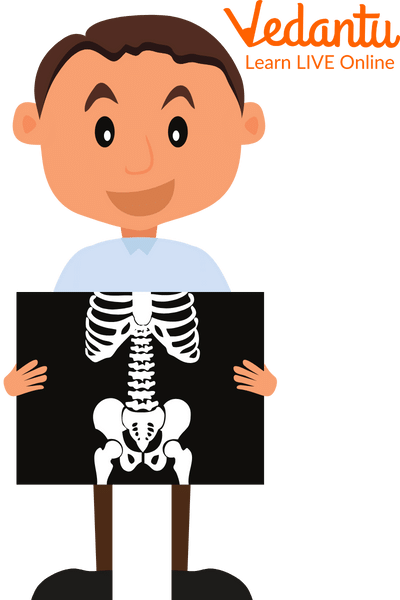
X-ray View of Bones
Human Skeleton System
The human skeleton system consists of 206 human bones in total that make up the backbone of every single human.
At the time of birth, a child is born with 300 human bones consisting of their body. According to researchers the extra bones in a child mature and fuse together to give rise to stronger adult bones.
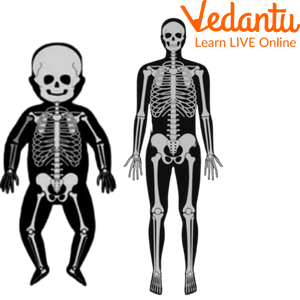
Bones in a Baby and an Adult
The above image shows pictures of the skeleton for both infants and adults. The structure of the human skeletal system is divided mainly into two parts that are the axial and appendicular skeletal systems.
Structure of Skeleton
Axial Skeleton
The axial skeletal system is made up of up to 80 bones namely the skull, vertebral column, sternum, ribs, and ear ossicles (ear bones) that are placed along the primary axis of the body and constitute the axial skeleton. Below are the bones that comprise the axial skeleton:
The skull has two types of bones, namely the facial and the cranial bones. They make up to 22 bones in total.
Cranial bones are 8 in number. They make the outermost protective covering of the brain, called the cranium.
The facial region comprises 14 bones.
A characteristic U-shaped bone named hyoid that does not articulate with any other bone in the body is present in the neck. It supports the tongue.
Each human middle ear has three tiny bones or ossicles namely malleus, incus, and stapes.
The above-stated bones comprise the structure of the human skeleton and the skull.
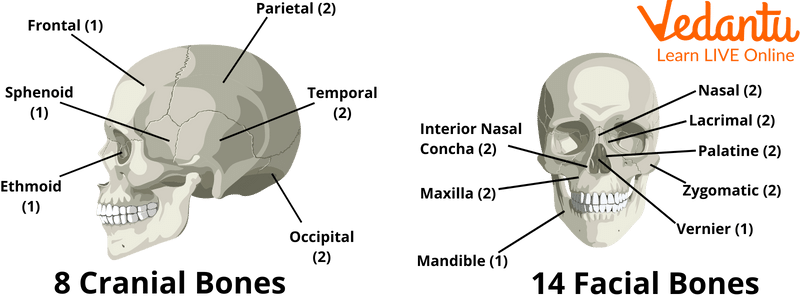
Skull Bones
Vertebral Column
These comprise serially arranged 26 bones or units called vertebrae. The first one of them is called the atlas and helps in the attachment of the skull and the vertebral column. The vertebral column is divided into cervical, thoracic, lumbar, sacral, and coccygeal regions.
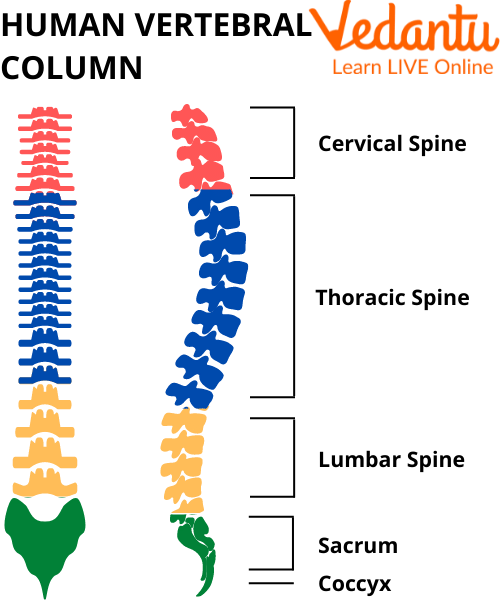
Vertebral Column and its Distinct Regions
Ribs and the Rib Cage
Humans have 12 pairs of ribs in their body that dorsally articulate with the vertebral column and ventrally with the sternum. The first seven pairs of ribs are called true ribs. The 8th, 9th, and 10th ribs are called vertebrochondral ribs or false ribs as they are attached to the sternum through hyaline cartilage. Whereas the remaining two pairs are called floating ribs as they do not connect ventrally with the vertebral column.
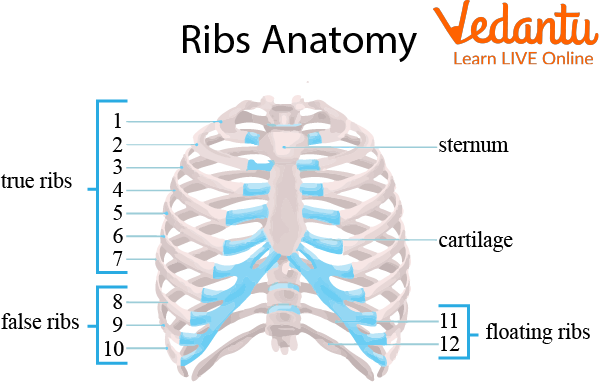
Ribs
Appendicular Skeletal System
This system comprises the bones of the limbs. Each limb has 30 bones which in turn makes 4x30 =120 bones in total. The bones of the hands are called the humerus, radius, ulna, carpals, metacarpals, and phalanges. Whereas the bones of the legs are called the femur, tibia, fibula, tarsals, metatarsals, and phalanges, respectively.
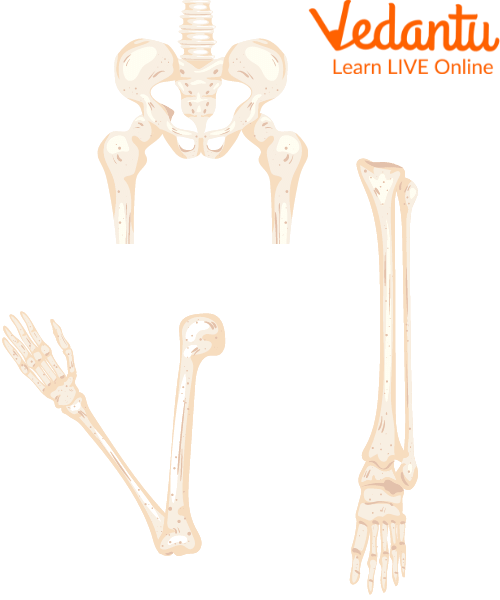
Appendicular Skeleton
Skeletal System Facts
The human skeletal system is unique and here are some of the skeletal system facts.
There is one bone in the body that is not connected to any other bone for functioning, the bone is the hyoid bone.
1% of the world's population has a unique 13-rib system.
Our bones are made of strong calcium salts and designed to take all the wear and tears throughout our lifetime but our teeth are even stronger than our bones.
Various disorders like arthritis and osteoporosis are very common bone diseases that happen due to autoimmune response or old age respectively.
The smallest bones are present in our ears. Stapes are a part of the ear ossicles and are the smallest bone of the human skeleton.
Summary
The human body is framed into a particular framework called the skeletal system and the structural and functional units of the skeletal system are bones. Without a skeletal structure, getting up would require a lot of crawling on the ground. Your body's basic shape is determined by the skeletal system's bones. Your bones would still be formed like a human even if you could remove everything else. Your skull and rib cage are two examples of bones that protect delicate organs. For instance, your skull shields your brain, and the rib cage that houses your heart and lungs keeps them comfortable and secure.
FAQs on Human Bone - Structure of Human Skeletal System
1. What is the study of bones called?
Scientifically the study of bones is called osteology. In this field of research the detailed structure of its elements, how they function, and related diseases are studied. It tells us that bones are interiorly made up of spongy tissues so that they can easily absorb shocks. Our body comprises 206 bones that articulate with each other and perform their functions in a coordinated manner. The place where two bones are attached is called a joint which allows the movement of the bones.
2. Bones are made up of which cells?
Bones are always renewing and remodeling themselves using various cells:
Osteoblast: These are the cells that are mainly responsible for repairing and mineralizing older bones.
Osteocytes: They are the connective/communicative cells that maintain the connection between osteocytes and osteoblasts.
Osteoclast: They are the largest cells in bones; they usually demineralize and break the bones.
The above are three bone cells that are essentially involved in making, repairing, and reabsorbing the bones and their salts to maintain calcium levels in the body.
3. Are teeth and bones similar?
Bones and teeth both have comparable appearances and characteristics in common, such as being the body's toughest tissues. However, teeth aren't made of bone and are not comparable to bones.









